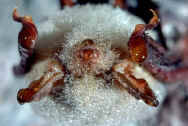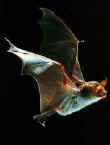Greater Mouse-eared
 The
Greater Mouse-eared bat (Myotis myotis) was supposed to have become
extinct in Britain when a lone 17 year old male did not return to his hibernation
site in Sussex in 1991. The last known colony was a few miles from Bognor
Regis and contained several females until 1985 which was the year of their
mysterious disappearance. Their departure happened around the time that
a nearby cottage was destroyed by fire and as the females tend to form maternity
colonies in attics they may have perished in this incident.
The
Greater Mouse-eared bat (Myotis myotis) was supposed to have become
extinct in Britain when a lone 17 year old male did not return to his hibernation
site in Sussex in 1991. The last known colony was a few miles from Bognor
Regis and contained several females until 1985 which was the year of their
mysterious disappearance. Their departure happened around the time that
a nearby cottage was destroyed by fire and as the females tend to form maternity
colonies in attics they may have perished in this incident.
However an emaciated female was found (January 2001) in Bognor
Regis but died shortly afterwards. It is thought that she may have been
moving between hibernation sites and was caught out by the cold weather.
From her worn teeth she was presumed to be quite old. She was found within
5 miles of the last known colony. The BCT hope to survey the area this
summer to try and see if there are any more of this rare bat 'hanging
on in there'.
It is a large bat and would be the largest British bat if it is still present.
Its numbers declined in Europe during the 1970's but lately numbers appear
to have stabilised.
 The
Greater Mouse-eared Bat is primarily a cave dweller and suffers from extensive
disturbance and loss of roosts. In most caves only a few bats may be found,
but some caves are immensely important because thousands of bats from
a wide area gather in them. Unfortunately the largest numbers of bats
tend to be found in the largest caves, these are generally the most prone
to disturbance through vandalism, caving, tourism and waste disposal.
The
Greater Mouse-eared Bat is primarily a cave dweller and suffers from extensive
disturbance and loss of roosts. In most caves only a few bats may be found,
but some caves are immensely important because thousands of bats from
a wide area gather in them. Unfortunately the largest numbers of bats
tend to be found in the largest caves, these are generally the most prone
to disturbance through vandalism, caving, tourism and waste disposal.
The decline of this bat is also associated with the widespread use of
agrochemicals, especially insecticides which can poison bats. The most important
agricultural change to affect these bats is the loss of pasture and increase in
area of improved grassland. This conversion significantly reduces the quantity
and variety of food insects available.
 Greater Mouse-eared bat call on a Time Expansion bat detector.
Greater Mouse-eared bat call on a Time Expansion bat detector.
| Description |
|
| Head and Body Length |
67 - 80 mm |
| Forearm Length |
54 - 68 mm |
| Wingspan |
350 - 450 mm |
| Weight |
28 - 40 g |
| Colour |
The dorsal fur is a sandy colour which contrasts strongly
with the white fur underneath. |
|
|
| |
|
| Life Cycle |
|
| Mating Period |
August onwards. |
| Maternity Colonies |
From March to June |
| Colony Size |
10 - 30 females.
Young: 1 born beginning of June. |
| Longevity |
22 years. |
| UK Status |
Extinct? |
|
|
| |
|
| Habitat and Food |
|
| Summer Roosts |
Stone buildings, trees. |
| Winter Roosts |
Caves, tunnels, mines. |
| Feeding Habitat |
Woodland bat. Also found in parks, pasture and human
settlement. |
| Food |
Ground beetles, cockchafers, dung beetles, grasshoppers,
crickets, moths, spiders. |
further reading
"Foraging
Bats Avoid Noise"
Andrea Schaub, Joachim
Ostwald, and Björn M. Siemers - Journal of Experimental Biology 211,
3174-3180 (2008)